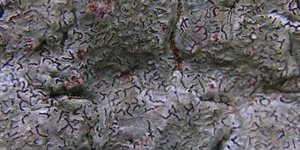Hypotrachyna afrorevoluta & H. revoluta
For some time the name Hypotrachyna afrorevoluta has been mentioned as a taxa that could be separated from the common Hypotrachyna revoluta but no one in Britain seemed clear on how to do this. It is not in the Hypotrachyna key in the Lichens of Great Britain & Ireland but is mentioned in the text under Hypotrachyna revoluta. In the last few years, however, the knowledge of how to tell them apart has been spread by Brian Coppins and it is actually quite easy. Only mature thalli can really be told apart, young thalli of both species (or of Parmelinopsis minarum for that matter) are very similar. Occasionally rather intermediate mature thalli can be found but most mature thalli are clearly assignable to one or other taxa.
Identification
Hypotrachyna revoluta: the most distinctive feature is the marginal raised lobes with soralia of fine pale grey soredia borne at the ends. The soredia are always concolorous with the thallus. The under side of the lobes are pale, but the underside of the attached thalli are black as in Hypotrachyna afrorevoluta.
Hypotrachyna afrorevoluta: this lacks raised marginal lobes and has the soralia originating as distinctive pustules derived from the break up of the upper cortex. The soredia can be concolorous with the thallus but are variable and range to greenish – brown. The underside is back as in Hypotrachyna revoluta and, as it lacks lobes there are no large pale areas are on the underside, but this is not a character that is independent of the presence of lobes.
The western rock growing Hypotrachyna britannica is very similar to Hypotrachyna afrorevoluta but has blue – black soredia and narrower more sinuous lobes. It is quite probably just a sun exposed rock morph of Hypotrachyna afrorevoluta but should continue to be recorded until this is definitely proven. Records of Hypotrachyna britannica from trees are likely to be actually Hypotrachyna afrorevoluta and most Hypotrachyna on rocks is also H. afrorevoluta. I have no pictures of H. britannica but these link1 & link2 are definitely this taxa.
Ecology
So far I have found Hypotrachyna afrorevoluta to be overwhelmingly dominant in clean western areas, occurring on rocks as well as trees. In these areas Hypotrachyna revoluta is present on trees but rare. In eastern areas with higher nitrogen deposition, Hypotrachyna revoluta becomes frequent but Hypotrachyna afrorevoluta can still be found.



